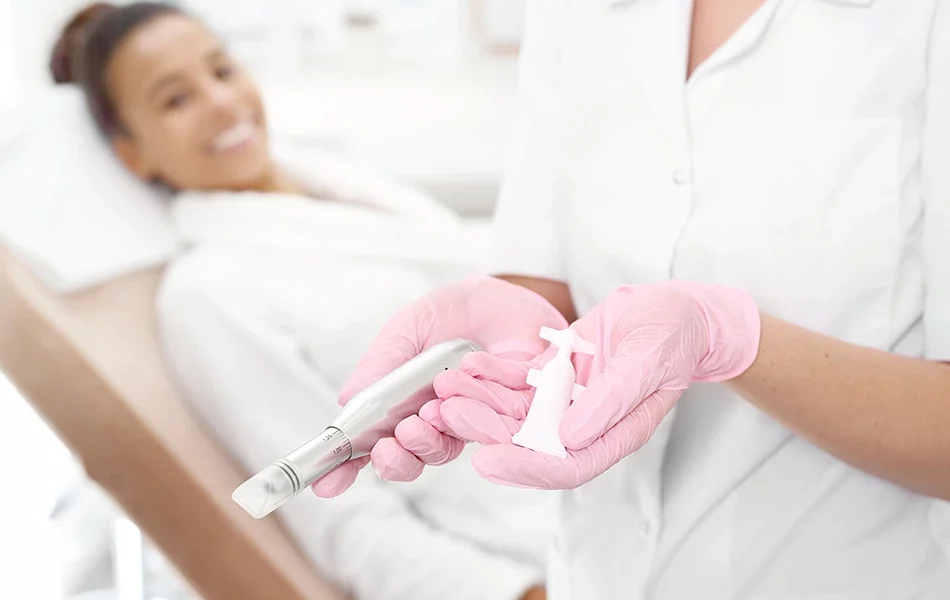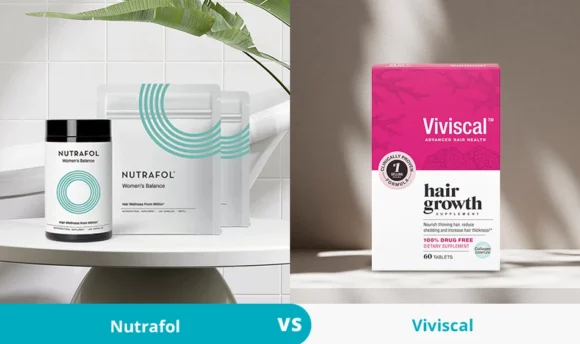Microneedling for Hair Growth: Is It Safe and Effective?
Microneedling provides calculated damage to your scalp that may promote hair regrowth. Is it worth trying and what are the side effects?

Hair loss can occur for many different reasons, from poor nutrition to different forms of alopecia. Microneedling for hair growth may stimulate hair regrowth in some patients.
Promoting hair growth through inflicting tiny wounds on your scalp with needles may sound counterintuitive. But some studies endorse this novel hair loss treatment.
Read on to find out how microneedling could help with hair regeneration and how exactly it works. Discover also the differences between professional microneedling and using derma rolls at home.
Microneedling for Hair Growth: A Bulletproof Method?
Scalp microneedling may lead to increased hair growth in alopecia areata, androgenetic alopecia, and other forms of pattern hair loss when used alongside topical hair regrowth lotions.
However, more human studies are needed to validate this treatment and investigate its long-term effects. For your safety, seek professional medical advice before signing up for a microneedling session.
What Is Microneedling?
Microneedling is a cosmetic procedure in which a handheld roller with small needles is applied to your scalp causing deliberate small injuries.
It’s typically performed by a plastic surgeon or dermatologist who will first apply a topical anesthetic to the treatment area.
The needle length may range from several millimeters to less than one millimeter. Microneedling isn’t normally painful, but it may be uncomfortable.
The medical practitioner performing microneedling may also apply a topical corticosteroid or topical minoxidil to promote new hair growth as part of a hair loss treatment.
So, how does microneedling help your hair? It’s theorized that microneedling may stimulate blood flow, deliver more nutrients to the hair follicles, and release factors that promote hair growth.
It may also stimulate dormant hair follicles and the production of stem cells and collagen to encourage fuller hair. Stem cells have regenerative powers, while collagen acts as an antioxidant that fights free radicals that may damage hair strands.
Microneedling has been used as a potential treatment for alopecia areata, an autoimmune disorder that causes patchy hair loss, androgenetic alopecia (male pattern baldness), and female pattern hair loss.
These treatments have also been used to promote healthier hair.
A 2017 review study suggests that microneedling together with topical minoxidil, topical steroids, and other medication can stimulate hair follicle growth. The procedure facilitates the penetration of such medication into the scalp.
However, at the time of writing, there are not sufficient studies to back these claims. Positive outcomes after microneedling are mostly anecdotal.
Microneedling devices for use at home are also available in the form of derma rolls. A derma roll is a handheld skin roller with needles. The process of using one is known as dermarolling.
Benefits of Microneedling
From increasing your hair count and treating alopecia areata to enabling hair regrowth, microneedling has many purported benefits. But what does science have to say about the benefits of scalp microneedling?
#1 May increase hair count
A 2013 pilot study investigated the effects of microneedling on patients with androgenic alopecia, a condition causing hair loss because of an excessive response to androgens, a type of hormone.
The study compared the results of a weekly microneedling procedure with minoxidil lotion applied twice daily with minoxidil application alone.
After 12 weeks, participants who also received microneedling had a significantly higher hair count. The microneedling group also reported greater satisfaction with the treatment compared with the minoxidil group.
#2 May treat hair loss resulting from alopecia areata
A 2014 study published in the International Journal of Cutaneous and Aesthetic Surgery proposed a novel treatment method for patchy hair loss caused by resistant alopecia areata.
In the study, one male and one female patient received microneedling with a derma roller and triamcinolone acetonide applied topically.
Triamcinolone acetonide is a cortisone medication used to treat alopecia and skin conditions like dermatitis or eczema.
After 3 sessions carried out in a 3-week interval, both patients showed excellent hair growth without any adverse effects.
#3 May stimulate hair growth
Microneedling may promote hair growth by stimulating the release of hair growth factors such as fibroblast growth factor and ensuring that more nutrients reach the hair follicles.
Fibroblast growth factors have been shown to stimulate hair growth in animal studies. They occur as part of the repair process that happens after microneedling.
Other animal studies show that microneedles can induce hair growth by activating pathways associated with hair-growth factors like vascular endothelial growth factor (VEGF) and β-catenin.
The bottom line is that microneedling may enable some people to regrow hair or achieve thicker hair. However, more studies are needed to prove that microneedling for hair loss is truly beneficial.
Side Effects of Microneedling
Microneedling or using derma rolls can cause a variety of side effects ranging from unpleasant to painful. These occur because of the damage the needles cause to the scalp and can include:
- Pain
- Swelling
- Irritation
- Itching
- Bruising
- Bleeding
- Redness
- Scars
- Scalp sensitivity to the sun
- Risk of infection
Having acne or eczema, suffering from diabetes, or taking blood thinners can increase the risk of experiencing unpleasant symptoms when microneedling for hair growth.
You are more likely to experience microneedling side effects if you use derma rolls at home, the procedure is not carried out by an expert, or proper hygiene is not followed during and after the procedure.
In the end, whether carried out at home or in a clinic, microneedling comes with a risk of infection.
Does Dermarolling Help With Hair Loss?
Dermarolling punctures your skin with a handheld roller with tiny needles on it to replicate the benefits of microneedling.
In theory, dermarolling may increase blood flow, stimulate hair growth factors, and enable hair growth lotions to reach the hair follicles and, through these, the hair shaft.
However, during a professional microneedling treatment, a health expert will use their experience to adjust the size of the needles and handle the device with dexterity to minimize side effects.
What’s more, they will also work in a sterile environment to eliminate infection and may use a more effective topical balm than those available commercially.
There’s a lot that can go wrong when you use derma rolls at home, from applying too much or not enough pressure to infection.
It’s also important to remember that microneedling requires regular use to yield results. Each additional at-home session further increases the risk that something may go wrong.
The bottom line is that microneedling requires expertise and good-quality equipment. Using derma rolls at home, while more affordable, can be a hit-or-miss procedure.
How to Use a Derma Roller for Hair Growth: DIY Treatment at Home
Keen to use a derma roller for hair growth despite the drawbacks and potential side effects? Here’s a simple step-by-step guide to help you.
There are a few things you should know before you start:
- Sterilize the derma roller by soaking it in alcohol before and after each use.
- Don’t use a derma roller on wet hair.
- Before use, inspect the needles. If you find bent or damaged needles, throw away the roll and get a replacement.
- Replace your derma roller at least every 2 months.
It’s also important to know how to use a derma roller correctly:
- Run the roller across your entire scalp applying some pressure. But don’t press too hard so that it causes you pain.
- Move the derma roller along your skin vertically, horizontally, and diagonally.
- Don’t run the roller too much over the same area. This can increase the risk of infection or serious injury.
- Use the derma roller 1–2 times a week. Microneedling for hair loss more often is not recommended. Give wound healing time.
Important: If you have sensitive skin, talk to your doctor before using a derma roller.
In the end, remember that microneedling for hair growth is best carried out in a dermatologist’s office.
FAQs
Microneedling procedures may be uncomfortable, but they are not painful. Topical anesthetics can be applied.
Microneedling is a minimally invasive procedure that shouldn’t damage the follicles if performed correctly.
There are no clear guidelines on this, but you can start microneedling 1–2 times a week. Avoid doing it more often.
Microneedling may start showing results in as little as 6 weeks though more consistent results occur after 3–6 months.
A Word From a Trichologist
The careful and controlled damage to the scalp that is achieved with professional microneedling stimulates skin repair processes.
During these, growth factors, proteins, and nutrients may reach the hair follicles and promote hair regrowth. The process may also boost scalp health by increasing collagen production and blood flow.
Microneedling won’t magically grow hair overnight. But it’s one of the hair growth treatments today supported by a handful of studies.
It’s also important to bear in mind that microneedling itself may cause some hair loss initially. This occurs due to damage to the hair threads. However, this is a natural aspect of the microneedling process.
If you are concerned about hair thinning or falling, consider a multi-approach treatment.
Improve your nutrient intake, use high-quality hair care products, and compare different hair growth treatment options such as avocado, coconut oil, argan oil, silica, and rice water.
Most importantly, discuss your situation with a medical professional. This way, you can better understand how you can stimulate hair growth and receive adequate treatment.
Conclusion
Microneedling for hair growth is currently not supported by a consistent body of research. However, some studies indicate that it can help treat hair loss by stimulating hair follicles and enabling hair regrowth.
If you are disappointed by conventional therapy and want to try microneedling for hair growth, keep in mind that the procedure carried out by a trained professional is safer than dermarolling at home.
Despite its apparent simplicity, this is a treatment that requires proper preparation, the right gear, and expertise. For the best chance at success, seek professional microneedling therapy.

















































 Select your language:
Select your language: 








